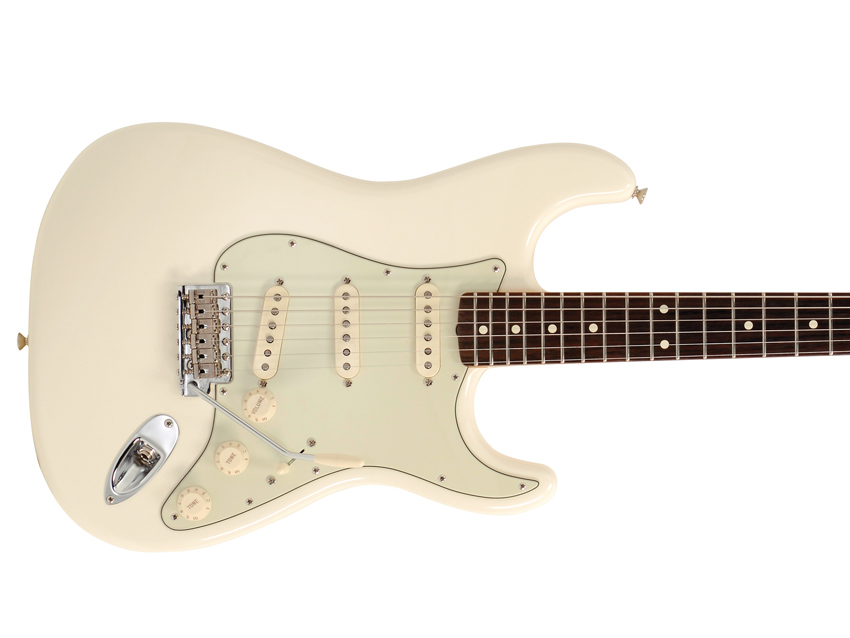MusicRadar Verdict
The '62 Vintage Hot Rod is without doubt the Strat to buy if you won't compromise on vintage aesthetics and tone, but are crying out for those real-world playability traits.
Pros
- +
Flatter 'board, bigger frets, less sticky neck. Hum-cancelling in-between settings. Ace pickups.
Cons
- -
Neck pocket not as perfect as the '57, albeit still fine.
MusicRadar's got your back
For some players, anything post 1964 or thereabouts just won't do when it comes to Fender Stratocaster aesthetics. Such enthusiasts absolutely insist on the 'right' body curves, nitro-cellulose lacquer, spaghetti peghead logo, vintage-style vibrato and Klusonesque, slot-head tuners.
And if you want all that from Fender's non-Custom Shop line, your only option is the American Vintage series.
Those guitars have their drawbacks for modern-minded players, however, notably their thin frets, too-curvy-for-big-bends 7.25-inch radius fingerboard, sticky nitro-finished necks and vintage single-coil pickups.
By and large, these were much the same 'problems' afflicting Strats back in the early/mid-1970s, even though the guitar had changed markedly by then from its 1950s forebear.
This drove many players to customise their guitars in line with new playing styles and sounds, and gave rise to a whole heap of aftermarket parts suppliers. It's to this legacy that Fender very gently doffs its cap with its new Vintage Hot Rod Stratocasters.
We're not talking out-and-out Floyd-plus-humbucker monsters like Van Halen's Frankenstein or Steve Vai's Green Meanie. We're not even talking two-pivot vibratos and clever switching aka the American Standards.
So why do we need these? Well, even the hugely popular American Standard Strat is a whole flight of steps too far for dyed-in-the-wool Strat enthusiasts: they don't want two-pivot vibratos, modern tuners, blocky logos, bi-flex truss rods, poly finishes and, heaven forefend, flashy modern colours. So let's keep those 'improvements' super subtle shall we?
Want all the hottest music and gear news, reviews, deals, features and more, direct to your inbox? Sign up here.
Overview
Despite the ostensibly similar appearance, there's plenty of clear water between the rosewood-'board '62 Hot Rod and the '57.
Similarities include the alder body and maple neck, tuning machines and bridge, while the most obvious differences are the aforementioned fingerboard and the three-ply, green-tinted pickguard in classic sixties Strat style.
While the latter makes no functional difference, the effects of a rosewood 'board are marked, not least in that many players prefer its 'softer', 'quicker' feel under the fingers compared with cellulose-finished maple.
It also benefits from the 9.5-inch radius, medium jumbo frets and rolled edges of the '57, although the action is adjusted a little higher on this particular guitar: very much a matter of taste.
One issue you'll want to be aware of is the weight difference between these two guitars; the '57 model is significantly lighter than the '62, suggesting the tolerances for weight are relatively wide for Vintage Hot Rods, so do try before you buy if pounds and ounces are as important to you as pounds and pence: guitars will vary from model to model for sure.
The pickups in this guitar vary only slightly from 'normal' '62 spec in that we have a trio of American Vintage single-coils, but the middle pickup is reverse wound/reverse polarity, meaning that the in-between positions on the five-way selector (two and four) are hum-cancelling: good news for all you Knoplfer fans who can't live with the buzz.
These Alnico V, staggered magnet pickups also feature Formvar wire and bevelled polepieces, all essential stuff for vintage-aholics. Moving forward a few years, the bridge pickup is then wired to the lower tone control, which is a sensible mod for any Strat as it enables you to smooth out the high-end.
Sounds
There's a good deal of hubris - some of which is deserved - when it comes to replacement pickups for guitars. But before you go spending all that cash, just listen to Fender's latest incarnation of its American Vintage single-coils.
These are relatively low-power units (Fender claims 5.3k DC resistance) but that's absolutely to their benefit, bringing out shimmering highs and a warm bottom end with that characteristic slight scoop in the middle that's quintessential Strat.
You might want to think of it as 'woody', because the pickups are in no way overpowering what the body and neck bring to the table.
While the bridge pickup in isolation can sound a little spiky played dead clean (also classic Strat), the general feeling is of a full sounding, professional grade guitar that, when played next to a lesser model, makes you realise why you're spending the extra cash.
The rosewood 'board adds colour in the mid-range compared with the maple version, giving the impression of extra warmth, particularly with overdrive, though this is still the
more 'vintage' sounding of the two.
The hum-cancelling in-between selections (bridge and middle, middle and neck) can be a Godsend under stage lights and indeed in front of computer screens, assuming you like that kind of 'hollow' Strat tone of course.
Rest assured positions two and four on the '62 Hot Rod are as good as you'll hear. All up, if you want to know what a vintage-style rosewood-'board Strat should sound like, listen here.
These Vintage Hot Rod Stratocasters are the very antithesis of Fender's revolutionary new VG Stratocaster reviewed on the preceding pages. That's quite a feat given their ostensible similarities, and one that really bears testament to this basic design's timelessness and immense versatility.
Guitarist is the longest established UK guitar magazine, offering gear reviews, artist interviews, techniques lessons and loads more, in print, on tablet and on smartphones
Digital: http://bit.ly/GuitaristiOS
If you love guitars, you'll love Guitarist. Find us in print, on Newsstand for iPad, iPhone and other digital readers

